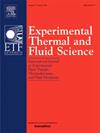An experimental study on the influence of variable film-hole diameter and arrangement on unsteady cooling performance
IF 2.8
2区 工程技术
Q2 ENGINEERING, MECHANICAL
Experimental Thermal and Fluid Science
Pub Date : 2025-01-21
DOI:10.1016/j.expthermflusci.2025.111415
引用次数: 0
Abstract
To reduce the unsteadiness and enhance the time-averaged film coverage performance, a novel conception of variable hole-diameter and arrangement is suggested. Five rows of film-holes with diameters ranging from 0.0020 m to 0.0038 m are embedded on a flat plate, including five kinds of arrangements. The effects of arrangement scheme, blowing ratio and plate thickness on the unsteadiness and time-averaged behaviors are experimentally investigated by time-resolved quantitative light sheet technique. The spatial modes of large-scale structures are analyzed by proper orthogonal decomposition analysis, and the flow field are characterized by momentum thickness and velocity distribution. The present work reveals two important and valuable phenomena: 1) For the thin plate (small length-to-diameter ratio, L/D), the arrangement of “hole-diameter from large to small” can achieve the highest time-averaged film coverage performance and the lowest unsteadiness than the other arrangements. 2) Compared with the thick plate (large L/D) with unchanged hole-diameter, the thin plates with the arrangements of “hole-diameter from large to small” and “small hole-diameter in the middle” can provide higher time-averaged performance and lower unsteadiness. This exploration may provide the investigators and designers of film cooling with a new thread.
求助全文
约1分钟内获得全文
求助全文
来源期刊

Experimental Thermal and Fluid Science
工程技术-工程:机械
CiteScore
6.70
自引率
3.10%
发文量
159
审稿时长
34 days
期刊介绍:
Experimental Thermal and Fluid Science provides a forum for research emphasizing experimental work that enhances fundamental understanding of heat transfer, thermodynamics, and fluid mechanics. In addition to the principal areas of research, the journal covers research results in related fields, including combined heat and mass transfer, flows with phase transition, micro- and nano-scale systems, multiphase flow, combustion, radiative transfer, porous media, cryogenics, turbulence, and novel experimental techniques.
 求助内容:
求助内容: 应助结果提醒方式:
应助结果提醒方式:


